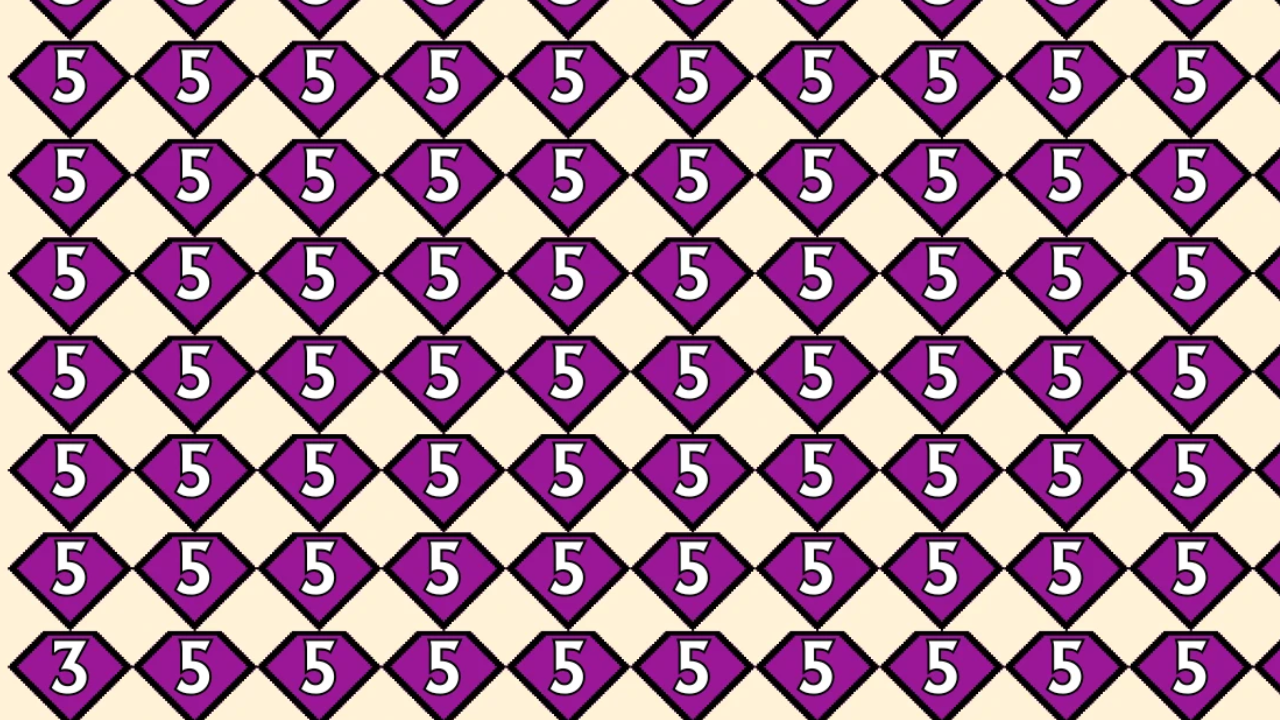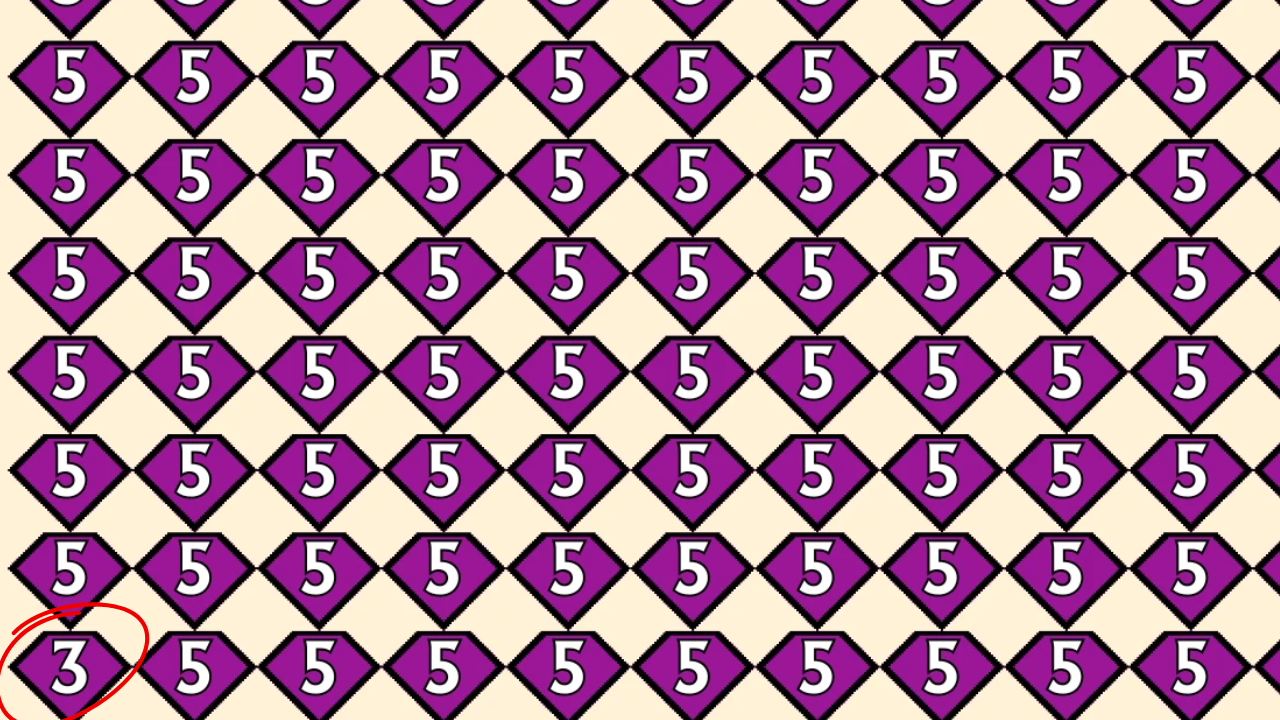Optical Illusion: In today’s fast-paced world, observation skills are more critical than ever. Whether you’re navigating a busy street, analyzing data at work, or simply enjoying a puzzle, your ability to notice details quickly can set you apart. One engaging way to test and hone these skills is through a classic observation challenge: spotting the number 3 among a sea of 5s in just three seconds. This seemingly simple task is a powerful exercise for your brain, combining speed, focus, and pattern recognition. In this 1500-word article, we’ll explore the science behind observation skills, why challenges like this are beneficial, how to improve your abilities, and tips to ace the “spot the 3” test. Let’s dive in!

The Importance of Observation Skills
Observation is the act of noticing and interpreting details in your environment. It’s a fundamental cognitive skill that underpins learning, problem-solving, and decision-making. From a young age, humans rely on observation to understand the world—watching caregivers, mimicking actions, and recognizing patterns. As we grow, these skills evolve, but they require regular practice to stay sharp.
In professional settings, keen observation can be a game-changer. Detectives rely on it to spot clues, scientists use it to identify anomalies in experiments, and designers notice subtle trends that inspire innovation. Even in everyday life, observation helps you read body language, avoid hazards, or find misplaced keys. Challenges like spotting a 3 among 5s tap into this skill, training your brain to process visual information quickly and accurately.
Why the “Spot the 3 Among 5” Test?
The “spot the 3 among 5” test is a classic visual puzzle designed to challenge your attention to detail. The task is straightforward: you’re presented with a grid or cluster of numbers, predominantly 5s, with a single 3 hidden among them. Your goal is to locate the 3 within three seconds. Despite its simplicity, the test is deceptively difficult because the numbers 3 and 5 share visual similarities—both have curves and straight lines, making it easy for your brain to gloss over the difference under time pressure.
This test is popular in brain teasers, IQ assessments, and even job interviews because it evaluates several cognitive abilities:
- Selective Attention: Your ability to focus on relevant details while ignoring distractions (in this case, the 5s).
- Pattern Recognition: Quickly identifying anomalies in a repetitive pattern.
- Processing Speed: How fast your brain can interpret visual information.
- Visual Discrimination: Distinguishing subtle differences between similar objects.
The three-second time limit adds an element of urgency, simulating real-world scenarios where quick thinking is essential. Whether you’re a student, professional, or just someone who loves a challenge, this test is a fun way to gauge and improve your observation prowess.
The Science Behind Visual Perception
To understand why spotting a 3 among 5s is challenging, let’s look at how the brain processes visual information. When you look at a grid of numbers, your eyes send raw data to the visual cortex, which interprets shapes, colors, and patterns. This process happens in milliseconds, but it’s not foolproof. The brain often takes shortcuts, grouping similar objects together to save energy—a phenomenon called perceptual grouping.
In the “spot the 3” test, the 5s form a uniform pattern, and the 3 is an outlier. However, because 3 and 5 are visually similar, your brain may initially group them as identical, causing you to overlook the 3. This is compounded by inattentional blindness, where you miss obvious details when focused on a specific task. The three-second deadline further stresses your cognitive resources, making it harder to break the pattern and spot the anomaly.
Neuroscientists also point to the role of the prefrontal cortex in tasks like this. This brain region governs attention and decision-making, helping you filter out irrelevant information. Training with visual puzzles can strengthen neural pathways, improving your ability to notice details under pressure.
Benefits of Observation Challenges
Engaging in tests like “spot the 3 among 5” offers numerous cognitive and practical benefits:
- Improved Focus: Regularly practicing observation tasks enhances your ability to concentrate, even in distracting environments.
- Enhanced Memory: Noticing details strengthens your working memory, helping you retain information longer.
- Faster Reaction Times: Quick-response challenges train your brain to process and act on information swiftly.
- Stress Management: Working under time constraints builds mental resilience, preparing you for high-pressure situations.
- Fun and Engagement: Puzzles are enjoyable, making learning feel like play rather than work.
Beyond cognitive gains, these skills translate to real-world applications. For example, drivers with sharp observation skills are better at spotting hazards, while professionals in fields like medicine or engineering can catch errors that others miss.
How to Ace the “Spot the 3 Among 5” Test
While the test is challenging, there are strategies to improve your performance. Here’s a step-by-step guide to mastering it:
- Relax Your Eyes: Instead of staring intensely, use a soft focus to scan the entire grid. This helps you see the bigger picture and spot anomalies faster.
- Look for Differences: Mentally note the key features of a 3 (e.g., its rounded top and bottom curves) versus a 5 (e.g., its flat top and hooked bottom). Train your brain to seek these distinctions.
- Scan Systematically: Divide the grid into sections and scan them quickly, moving left to right or top to bottom. This prevents you from getting overwhelmed.
- Practice Peripheral Vision: The 3 might not be in the center, so train your peripheral vision to catch outliers on the edges.
- Stay Calm Under Pressure: The three-second limit can induce panic, but staying relaxed improves clarity. Take a deep breath before starting.
- Practice Regularly: The more you expose yourself to similar puzzles, the better your brain gets at spotting patterns and anomalies.
If you don’t succeed at first, don’t worry—observation skills improve with practice. Try variations of the test with different numbers or time limits to keep challenging yourself.
Tips to Boost Observation Skills in Daily Life
Beyond puzzles, you can sharpen your observation skills through everyday activities. Here are some practical tips:
- Play “I Spy” Games: Whether alone or with others, try spotting specific objects in your environment, like a red car or a bird.
- Mindfulness Exercises: Practice being present in the moment, noticing sounds, smells, and sights around you.
- Change Your Routine: Take a different route to work or rearrange your desk. Novelty forces your brain to pay attention to new details.
- Study Faces: When meeting people, note specific features like eye color or hairstyle. This trains visual memory.
- Use Apps and Games: Apps like Lumosity or online brain teasers offer observation-based challenges to keep your skills sharp.
- Read Actively: When reading, pause to visualize scenes or question details. This enhances your ability to process and retain information.
Common Mistakes to Avoid
When attempting the “spot the 3” test, watch out for these pitfalls:
- Overfocusing: Staring too hard at one area can cause you to miss the 3 elsewhere.
- Rushing Without Strategy: Scanning randomly wastes time. Use a systematic approach.
- Second-Guessing: Trust your instincts. If you think you’ve spotted the 3, don’t overthink it.
- Ignoring Practice: Observation is a skill, not a talent. Without regular practice, your performance may plateau.
Variations of the Test
To keep things fresh, try these variations of the “spot the 3 among 5” challenge:
- Different Numbers: Swap the 3 and 5 for other similar pairs, like 8 and 0 or 6 and 9.
- Color or Font Changes: Use colored numbers or varying fonts to increase difficulty.
- Moving Patterns: Present the numbers in a dynamic grid that shifts, forcing you to adapt.
- Multiple Targets: Hide more than one 3 in the grid for an added challenge.
- Auditory Distractions: Play background noise while you search to simulate real-world multitasking.
The Role of Technology in Observation Training
Technology offers exciting tools to enhance observation skills. Apps like BrainHQ and Peak provide tailored exercises, while virtual reality (VR) games immerse you in environments where you must spot details to progress. Even social media platforms like X can be a resource—users often share visual puzzles or challenges that test your skills. Search for posts with hashtags like #BrainTeaser or #ObservationChallenge to find new tests.

Looking Ahead
The “spot the 3 among 5” test is more than just a game—it’s a window into your cognitive abilities and a chance to sharpen your observation skills. By understanding the science behind visual perception, practicing strategic scanning, and incorporating observation exercises into daily life, you can boost your focus, memory, and reaction times. Whether you’re aiming to ace the test or simply want to notice more in the world around you, this challenge is a fun and effective starting point. So, grab a grid, set a timer for three seconds, and see how quickly you can spot that elusive 3. With practice, you’ll be amazed at how much sharper your observation skills become!
